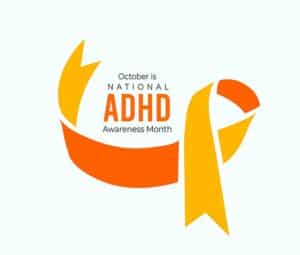Attention-deficit disorders, more commonly known as ADD or ADHD, can be as disruptive but treatable as many physical ailments. The stigma surrounding these disorders, however, can often lead to misinformation, shame, and delay of treatment. More than 6 million children have an ADD diagnosis in the United States as of 2021 as well as an estimated 5% of American adults.
3 Insights for ADHD Awareness Month

When is ADHD Awareness Month?
October is known as ADHD Awareness Month. Not to be confused with National Attention Deficit Disorder Awareness Day on September 7, ADHD Awareness Month is focusing on topics to reframe the narrative around the disorders such as ADHD relationships and communication, ADHD parenting, comprehensive treatment plans for ADHD, and co-occuring conditions with ADHD.
There are multiple types of attention-deficit disorders that can be categorized into 2 types of behavior problems: inattentiveness or hyperactivity and impulsiveness. The former is often correlated with Attention Deficit Disorder, and the latter with Attention Deficit Hyperactivity Disorder. Most people with these disorders have problems in both categories, but some can be inattentive without any hyperactivity symptoms.
Similarly, different genders often exhibit different symptoms. While young boys are three times more likely to be diagnosed than young girls, women are thought to suffer from ADHD and ADD as much as their male counterparts but show different, often more subtle signs of the disorder. Boys often exhibit signs like constant movement and impulsivity, while girls show more internalized symptoms like inattentiveness and low self-esteem.
Why is ADHD Awareness Important?
ADD and ADHD are surrounded by stigma and misinformation. Unfortunately, many still see attention deficit disorders as “not real” or that symptoms like inattentiveness can simply be overcome with more focus.
The ADHD Awareness Coalition, comprised of the Children and Adults with Attention-Deficit/Hyperactivity Disorder (CHADD), the Attention Deficit Disorder Association (ADDA), and ADHD Coaches Organization (ACO), focuses on presenting accurate information through websites, podcasts, and webinar trainings every October to increase awareness and correct some common misconceptions.
“Because ADHD has a range of presentations and a wide range of severity, ADHD is often difficult to understand,” CHADD CEO Bob Cattoi said. “The key is to understand that it is a neurodevelopmental issue. There are resources to help individuals affected by ADHD and those who support them. We’re here to help them move beyond the self-criticism that is often associated with ADHD, and to appreciate the strengths — creativity, curiosity, generosity — that individuals with ADHD bring to our society.”
Attention-deficit disorders are often diagnosed
alongside other mental health issues, such as anxiety disorder, depression, oppositional defiant disorder, conduct disorder, and sleep problems. Many diagnosed also suffer from learning difficulties like dyslexia as well as autistic spectrum disorder, epilepsy, or Tourette’s syndrome.
Though adult ADHD has been rarely studied, some conditions adults with ADHD may also have include personality disorders, bipolar disorder, and obsessive compulsive disorder.
Common Symptoms of ADHD
Like many disorders, attention-deficit disorders can present with a range of symptoms, and only a doctor can officially diagnose ADD or ADHD. Symptoms also differ among different genders and age ranges, and your symptoms can evolve as you age.
Some common symptoms of ADD or ADHD include:
- Having a short attention span
- Losing things often
- Constantly changing tasks
- Verbal aggression like teasing
- Lack of concentration
- Having difficulty organizing tasks
- Fidgeting and excessive physical movement
- Acting without thinking
- Interrupting conversations
- Physical aggression
- Forgetfulness
- Extreme impatience
- Mood swings and irritability
- Lack of attention to detail
- Unable to listen and follow instructions
Contact Us Today
If you or a loved one is experiencing a number of these symptoms, the first step to a diagnosis and treatment is a quick assessment with a psychiatrist, a psychologist, a pediatrician, a nurse practitioner, a neurologist, a master level counselor, or a social worker. Contact
us if you are or believe you could be ADHD or ADD.
